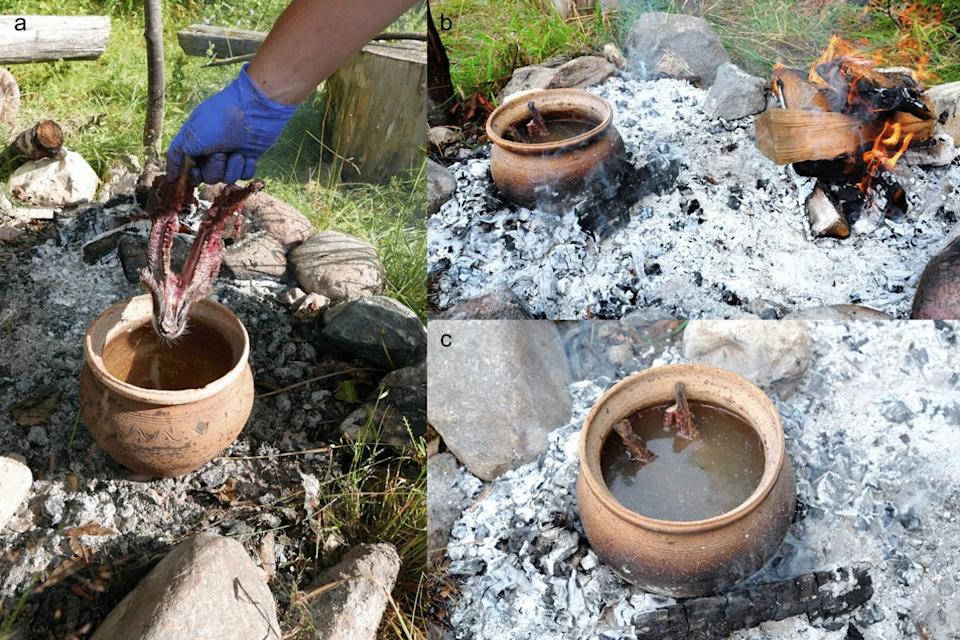Uncovering the Secrets of Stone Age Tooth Extraction: A Study of Prehistoric Ornament Production

In the prehistoric communities of what is now northeastern Europe, a common cultural practice involved the use of decorative ornaments made from animal teeth. These ornaments, found in the graves of Stone Age hunter-gatherers, offer a glimpse into the daily lives of our ancestors. However, one of the mysteries surrounding these ornaments is how the people in these settlements removed the teeth from animal skulls.
To find out, a team of archaeologists tested seven different teeth extraction methods and published their findings in a study in June 2023 in the journal Archaeological and Anthropological Sciences. The study, which focused on the Zvejnieki cemetery site in northern Latvia, dates back to approximately 7500 to 2500 BCE and has uncovered more than 2,000 animal teeth from various graves.
The team used experimental archaeology to test seven different extraction methods:
- Percussion – crushing the jaw bones using cobbles and wooden tools to loosen the teeth
- Scavenging/air-drying – leaving the jaw bone outdoors for an extended period of time to soften the bone and decompose the soft tissues to extract the teeth by hand
- Soaking – soaking a jaw bone for several weeks to soften the bone and decompose the soft tissues so that the teeth can be extracted by hand
- Direct heat/fire – exposing the jaw to direct heat from an open fire to dry out the bone and extract the teeth
- Wet cooking – simmering the jaw in a ceramic pot to allow the tissues to detach and extract the teeth by hand
- Pit steaming – placing the entire head in a cooking pit to detach the soft tissues
The team found that wet cooking and pit steaming were the most effective techniques for extracting teeth without damaging them. These methods also ensured that the meat was edible and the bones could be used to make tools, ensuring that nothing on the animal was wasted.
“Our experiments show that tooth extraction was a deliberate, time-sensitive process embedded in daily life, especially cooking practices,” said Aija Macāne, a study co-author and zooarchaeologist at the University of Helsinki in Finland. “This challenges the assumption that teeth used for ornaments were simply scavenged or easily available.”
The findings indicate that tooth extraction was not merely a functional task but served an integral role in broader cultural practices. Extracting these animal teeth intertwined food prep, making personal items to wear, and burial and death rituals. The study also calls for a reevaluation of what archeologists call the chaîne opératoire—or the sequence of actions that are involved in artifact production. A reassessment looking particularly at both ornament making and human-animal relationships could yield more insight into these millennia-old practices.
The team hopes that this work inspires further studies into the early stages of ornament production, including comparing prehistoric butchery practices and the extraction of both human and carnivore teeth. “By better understanding the extraction process, we gain deeper insight into the life histories of tooth pendants—from animal capture and processing, to ornament crafting, use, and final deposition,” said Macāne.
A thorough examination of prehistoric tooth extraction practices as a unique insight into the secrets behind Stone Age ornament production, offering valuable insights for understanding ancient technologies and social dynamics.
This study delves into the intricate world of Stone Age tooth extraction techniques, shedding light on how these practices were rooted in prehistoric ornamental production and rituals. It offers fascinating insights that challenge our understanding of early human social dynamics.
This thorough analysis, Uncovering the Secrets of Stone Age Tooth Extraction: A Study Of Prehistoric Ornament Production shed new light on our understanding about ancient technology and not just as a tool for survival but also an epitome in early cultural expressions.
This study 'Uncovering the Secrets of Stone Age Tooth Extraction: A Study on Prehistoric Ornament Production' provides a fascinating insight into ancient techniques and opens new avenues for understanding prehistoric aesthetics, societal dynamics as well as primitive technological advancements.
A probing journey into the hinterlands of prehistoric craftsmanship, this study 'Uncovering The Secrets Of Stone Age Tooth Extraction: A Study On Prehistoric Ornament Production' intriguingly reveals a kaleidoscope view on how human ingenuity shaped our predecessors’ artistic endeavors."


![Isothermal Bags Containers Market [2028]: Top Trends, Size, and Competitive Intelligence - TechSci Research](https://antiochtenn.com/zb_users/upload/2025/07/20250719012446175285948669203.jpg)











